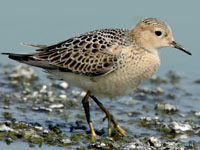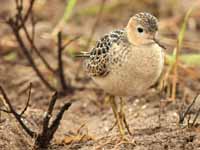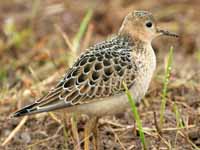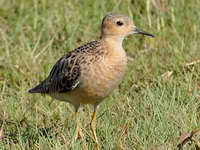THE WORLD BIRDS - An Online Bird Book
SHOREBIRDS
Small bill Sandpipers and Allies
Order Charadriiformes Family Scolopacidae
SHOREBIRDS
Most Shorebirds walk along shores probing for food with their thin sensitive bills. Bill length varies considerably so differing species can work the same shore and obtain different
food supplies. Shorebirds include sandpipers, godwits, stilts, oystercatchers, plovers, and many more. Shorebirds belong to the Charadriiformes order which also includes the Gulls
and Allies.
Note: the term Shorebirds is used in the Americas; elsewhere "waders" is used. We will reserve "waders" for herons and allies.
Some Charadriiformes families:
Burhinidae: thick-knees; Charadriidae: small plovers, lapwings; Glareolidae: courses, pratincoles; Haematopodidae: oystercatchers
Jacanidae: jacanas; Recurvirostridae: avocets, stilts; Scolopacidae: small bill sandpipers, large bill sandpipers
Note: the term Shorebirds is used in the Americas; elsewhere "waders" is used. We will reserve "waders" for herons and allies.
Some Charadriiformes families:
Burhinidae: thick-knees; Charadriidae: small plovers, lapwings; Glareolidae: courses, pratincoles; Haematopodidae: oystercatchers
Jacanidae: jacanas; Recurvirostridae: avocets, stilts; Scolopacidae: small bill sandpipers, large bill sandpipers
Small bill Sandpipers and Allies
Order Charadriiformes Family Scolopacidae
Sandpipers include many species called sandpipers, as well as those called by names such as curlew and snipe. They have long bodies and legs, and narrow wings. Most species have a narrow bill, but otherwise the form and length are quite variable. The bills are sensitive, allowing the birds to feel the mud and sand as they probe for food. They generally have dull plumage, with cryptic brown, gray, or streaked patterns, although some display brighter colours during the breeding season. Most species nest in open areas, and defend their territories with aerial displays. The nest itself is a simple scrape in the ground, in which the bird typically lays three or four eggs.
Genus Aphriza - 1 species
Surfbird Aphriza virgata Found: West Coast of The Americas
The breeding Surfbird has dark spots on breast and flanks; rusty wings; gray bill, orange near base; yellow legs. The nonbreeding adult bird has gray upperparts; lighter spots on breast and flanks. Surfbird usually found on rocky shores.
Similar to: Black Turnstone. Surfbird has yellow legs; Black Turnstone has dull reddish-brown legs.
Similar to: Great Knot. Great Knot is larger than Surfbird and its bill is proportionally longer.
Image by: 1, 3, 5) Len Blumin - Bodega Bay, California 2) Dick Daniels - Half Moon Bay, California 4) Andrej_Chudy - California 6) Alan D. Wilson -Near Victoria, British Columbia Similar to: Black Turnstone. Surfbird has yellow legs; Black Turnstone has dull reddish-brown legs.
Similar to: Great Knot. Great Knot is larger than Surfbird and its bill is proportionally longer.
1) First summer 2) Juvenile 3, 4) Nonbreeding 5, 6) Breeding
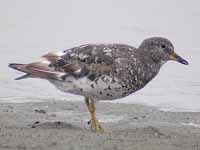

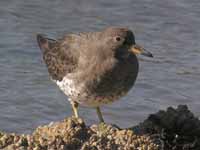
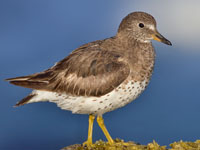
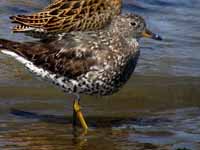
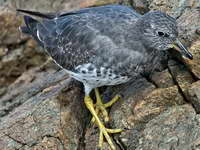
Genus Calidris
Calidrids have sensitive bills that they use to probe along the shoreline to search for food. They often move their feet very rapidly as they run along the water's edge. They fly long distances and many of the species are found on a number of continents.
Dunlin Calidris alpina Found: North America, Europe, Asia, Africa, Australia
The breeding Dunlin has reddish-brown back and head; black belly; long black drooping bill. Nonbreeding adult has brown upperparts; white underparts.
Similar to: Broad-billed Sandpiper. Broad-billed Sandpiper slightly smaller than the Dunlin, but with a longer straighter bill, and shorter legs.
Similar to: Curlew Sandpiper in the nonbreeding season. The Curlew Sandpiper has a longer and more curved bill than the Dunlin. The Curlew Sandpiper prefers a fresh water habitat, the Dunlin prefers salt water.
Similar to: Sanderling. Dunlin bill is longer. Sanderling bill is staighter and thicker at base.
Image by: 1, 3, 4, 5, 6, 7, 8, 9) Dick Daniels - North Carolina 2) Dick - Biloxi, Mississippi Similar to: Broad-billed Sandpiper. Broad-billed Sandpiper slightly smaller than the Dunlin, but with a longer straighter bill, and shorter legs.
Similar to: Curlew Sandpiper in the nonbreeding season. The Curlew Sandpiper has a longer and more curved bill than the Dunlin. The Curlew Sandpiper prefers a fresh water habitat, the Dunlin prefers salt water.
Similar to: Sanderling. Dunlin bill is longer. Sanderling bill is staighter and thicker at base.
1 - 4) Nonbreeding 5 - 8) Breeding


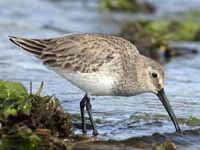
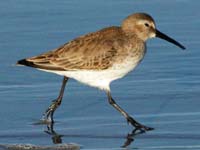
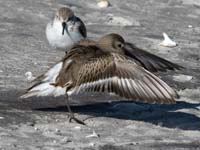
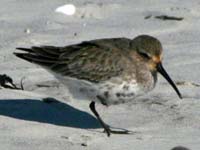
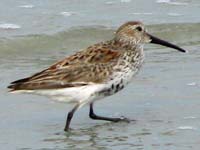

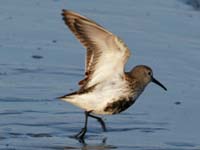
Knot,_Great Calidris tenuirostris Found: Asia, Australia
The breeding Great Knot has mottled grayish upperparts; heavily spotted breast; short dark legs; medium-length thin dark bill. Nonbreeding adultls have gray upperparts and much less spotting below.
Of the Calidris sandpipers, the Great Knot is the largest and Red Knot is second largest.
Similar to: Black Turnstone, Red Knot, Surfbird. Great Knot is larger than Black Turnstone, Red Knot or Surfbird and its bill is proportionally longer.
Image by: 1) JJ Harrison - Thailand 2) Aviceda - Scarborough, SE Queensland, Australia 3) Graham_Winterflood 4) Karzedracer - Queensland AUOf the Calidris sandpipers, the Great Knot is the largest and Red Knot is second largest.
Similar to: Black Turnstone, Red Knot, Surfbird. Great Knot is larger than Black Turnstone, Red Knot or Surfbird and its bill is proportionally longer.
1) Nonbreeding 2, 3, 5) Breeding
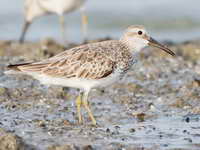
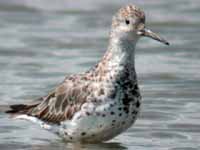
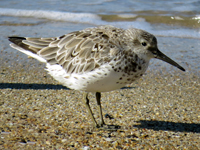
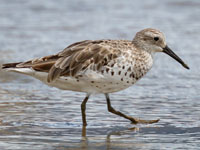
Knot,_Red Calidris canutus Found: The Americas, Europe, Asia, Africa, Australasia
The breeding Red Knot has mottled gray upperparts; reddish head and underparts with light colored rear belly; dark legs, medium thin dark bill. The nonbreeding adult has gray upperpart including the head; pale gray underparts; light eye-line; yellowish-green legs.
Similar to: Great Knot, Great Knot is larger than Red Knot and its bill is proportionally longer.
Similar to: Sanderling. Nonbreeding Red Knot and Sanderling have straight black bill and black feet. But size difference and rapid movement of Sanderling makes it easy to differentiate between them.
Image by: 1) Mick - France 2, 3, 5, 6, 7, 8, 9, 10) Dick - North Carolina 4) Dick - Sanibel Island, Florida Similar to: Great Knot, Great Knot is larger than Red Knot and its bill is proportionally longer.
Similar to: Sanderling. Nonbreeding Red Knot and Sanderling have straight black bill and black feet. But size difference and rapid movement of Sanderling makes it easy to differentiate between them.
1, 2) Juvenile 3) Juvenile, adult 4) Nonbreeding adult 5 - 9) Breeding adult

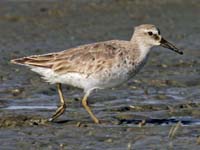

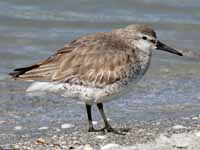
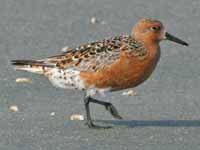
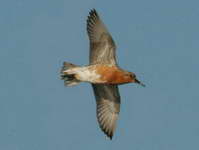
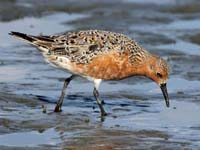

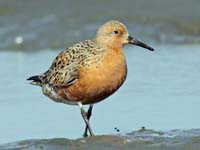
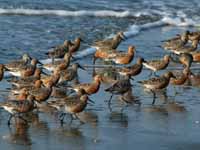
Sanderling Calidris alba Found: The Americas, Europe, Africa, Australia
The breeding Sanderling has mottled rufous upperparts; white underparts; black bill and feet. Nonbreeding adult has light gray upperparts. It is characteristicly see running at shores edge with rapidly moving feet.
Similar to: Dunlin. Dunlin bill is longer. Sanderling bill is staighter and thicker at base.
Similar to: Red Knot. Nonbreeding Red Knot and Sanderling have straight black bill and black feet. But size difference and rapid movement of Sanderling makes it easy to differentiate between them.
Similar to: Semipalmated Sandpiper. Nonbreeding Sanderling upperparts are gray; breeding Sanderling upperparts are rufous. Semipalmated Sandpiper is gray-brown.
Image by: 1) Dick Daniels - Homer, Alaska 2, 3, 4, 5, 6, 7, 8, 9) Dick - North Carolina Similar to: Dunlin. Dunlin bill is longer. Sanderling bill is staighter and thicker at base.
Similar to: Red Knot. Nonbreeding Red Knot and Sanderling have straight black bill and black feet. But size difference and rapid movement of Sanderling makes it easy to differentiate between them.
Similar to: Semipalmated Sandpiper. Nonbreeding Sanderling upperparts are gray; breeding Sanderling upperparts are rufous. Semipalmated Sandpiper is gray-brown.
1) Juvenile 9) Breeding

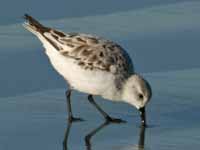

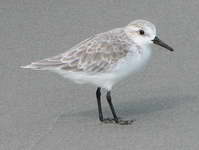
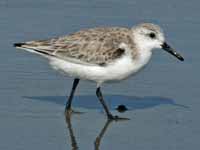
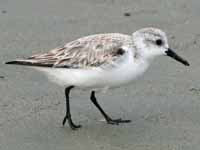
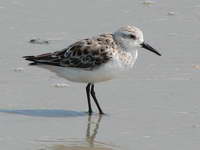

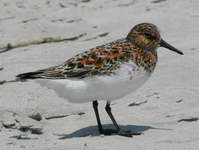
Sandpiper,_Baird's Calidris bairdii Found: The Americas
The breeding Baird's Sandpiper has black bill and feet; mottled brown on top; mainly white underparts; black rump. The nonbreeding adult has paler brown upperparts.
Similar to: Western Sandpiper, Semipalmated Sandpiper. Baird's Sandpiper considerably larger than Western and Semipalmated sandpipers. Also, wings of standing Baird's Sandpiper extend beyond tail, but this is not the case for Western and Semipalmated sandpipers.
Similar to: White-rumped Sandpiper, When flying, the White-rumped Piper has a visible white rump, the Baird's Sandpiper does not.
Image by: 1) Bill Bouton - California 2) Maggie Smith - Old Creek, Cayucos,
California
3) Dominic Sherony 4) Seabrooke Leckie - Toronto 5) Dick Daniels - ChileSimilar to: Western Sandpiper, Semipalmated Sandpiper. Baird's Sandpiper considerably larger than Western and Semipalmated sandpipers. Also, wings of standing Baird's Sandpiper extend beyond tail, but this is not the case for Western and Semipalmated sandpipers.
Similar to: White-rumped Sandpiper, When flying, the White-rumped Piper has a visible white rump, the Baird's Sandpiper does not.
1, 2) Juvenile

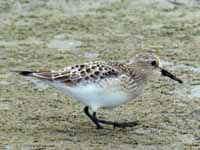
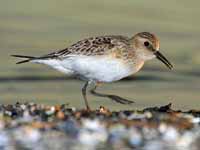
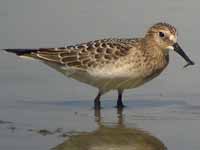

Sandpiper,_Broad-billed Calidris falcinellus Found: Europe, Asia, Africa, Australasia
The breeding Broad-billed Sandpiper has mottled upperparts with black centers and rufous edges; white underparts with streaked upper breast; distintive head has wide dark median crown stripe next to thinner white stripe, black stripe, white supercilium; long black bill with broad base and drooped tip; dark olive legs. Nonbreeding adult liighter back.
Similar to: Dunlin. Broad-billed Sandpiper slightly smaller than the Dunlin, but with a longer straighter bill, and shorter legs.
Image by: 1) Nik_Borrow - Gabon 2) Sreedev Puthur - India 3) Alastair RaeSimilar to: Dunlin. Broad-billed Sandpiper slightly smaller than the Dunlin, but with a longer straighter bill, and shorter legs.
1) Nonbreeding 3) Breeding
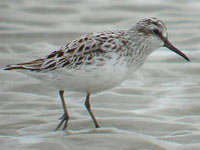
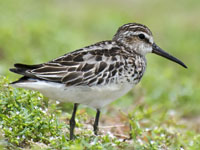
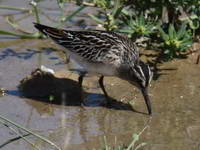
Sandpiper,_Curlew Calidris ferruginea Found: North America, Europe, Asia, Africa, Australasia
The breeding Curlew Sandpiper has mottled gray upperparts; red underparts; black down-curved bill. The nonbreeding adult has lighter gray upperparts; white underparts.
Similar to: the Dunlin in the nonbreeding season. The Curlew Sandpiper has a longer and more curved bill than the Dunlin. The Curlew Sandpiper prefers a fresh water habitat, the Dunlin prefers salt water.
Image by: 1) Kev Chapman 2) Lip Kee Yap - Buloh Wetland Reserve, Singapore 3, 4) Dick Daniels - Madagascar 5) Ómar Runólfsson - Iceland 6, 8) Mick Sway 7) Changhua Coast Conservation ActionSimilar to: the Dunlin in the nonbreeding season. The Curlew Sandpiper has a longer and more curved bill than the Dunlin. The Curlew Sandpiper prefers a fresh water habitat, the Dunlin prefers salt water.
6, 7, 8) Breeding
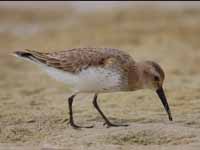
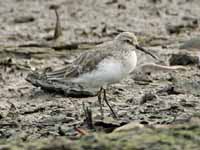


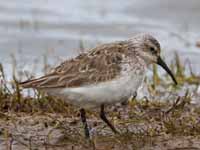
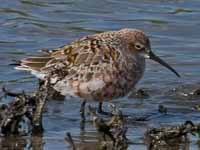

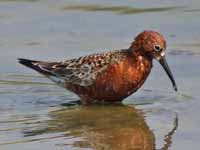
Sandpiper,_Least Calidris minutilla Found: The Americas
The breeding Least Sandpiper has mottled brown upperparts; some mottling on upper breast; rest of underparts white; light colored supercilium; short straight dark bill; greenish-yellow legs. Nonbreeding adult has grayish-brown upperparts. It is the smallest of the Calidris.
Similar to: Long-toed Stint. Long-toed Stint has more slender and longer-necked appearance than Least Sandpiper. Ranges do not overlap.
Image by: 1) Mike Baird - California 2) Britta - CA
3) Gregory_Smith - CA 4) Alan D. Wilson - British ColumbiaSimilar to: Long-toed Stint. Long-toed Stint has more slender and longer-necked appearance than Least Sandpiper. Ranges do not overlap.
5) New Jersy Birds 6, 7) Dick Daniels - North Carolina 8) Dick - New Jersey
1, 2) Nonbreeding 3 - 8) Breeding
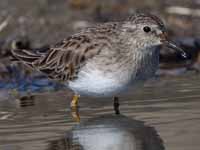
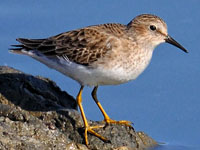
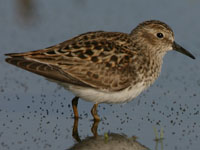
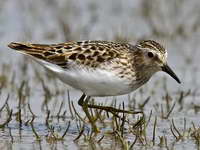
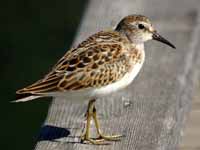
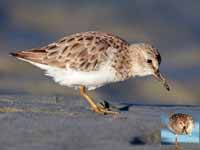
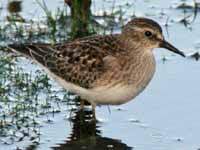
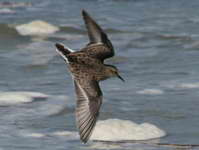
Sandpiper,_Pectoral Calidris melanotos Found: The Americas, Europe, Asia, Africa, Australia, New Zealand
The breeding Pectoral Sandpiper has brown upperparts; white underparts with brown upper breast; yellowish legs; olive bill with darker tip. The nonbreeding adult has gray-brown back.
Similar to: Sharp-tailed Sandpiper. The Sharp-tailed Sandpiper has a strong eye-ring conpared to the Pectoral Sandpiper.
Image by: 1) Alan D. Wilson - British Columbia 2) Dick Daniels - New Jersey 3) Cláudio Timm - Rio Grande do Sul, Brazil 4) Dominic
SheronySimilar to: Sharp-tailed Sandpiper. The Sharp-tailed Sandpiper has a strong eye-ring conpared to the Pectoral Sandpiper.
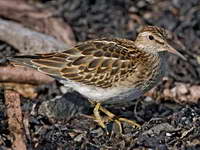
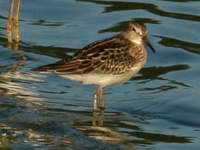
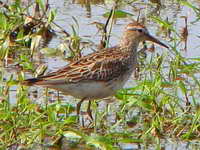
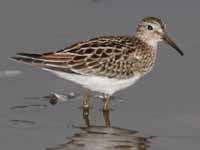
Sandpiper,_Purple Calidris maritima Found: North America, Europe, Asia, Africa
The breeding Purple Sandpiper is dark on top; mainly white underparts; dark bill with yellow base; yellow legs. Nonbreeding adult is dark gray on top with perhaps a purplish tint.
Similar to: Rock Sandpiper. Nonbreeding adults can be difficult to tell apart. Range can sometimes be helpful.
Image by: 1) Becky Gregory - Maryland 2) Mjobling 3) Frans_Vandewalle - Belgium 4) S Fiztgerald - Texas 5) Paul Roberts - Great Britain 6)
Andreas Trepte Similar to: Rock Sandpiper. Nonbreeding adults can be difficult to tell apart. Range can sometimes be helpful.
1) Juvenile


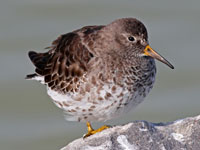



Sandpiper,_Rock Calidris ptilocnemis Found: northern Pacific coast of North America, Asia
The breeding Rock Sandpiper has rufous back with gray near the flanks; blackish belly patch; pale head with darker top; dark bill; dark legs with yellow tinge. The nonbreeding adult has gray back; lighter belly; dark bill with yellow-green base; yellow legs.
Similar to: Purple Sandpiper. Nonbreeding adults can be difficult to tell apart. Range can sometimes be helpful.
Image by: 1) Dick Daniels - Alaska 2) Calypso Orchid 3) Marcel Holyoak - California 4) Alan D. Wilson - AlaskaSimilar to: Purple Sandpiper. Nonbreeding adults can be difficult to tell apart. Range can sometimes be helpful.
1) Juvenile 2, 3) Nonbreeding 4) Breeding
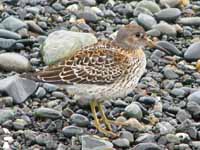

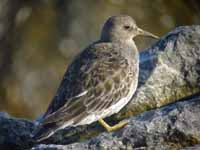

Sandpiper,_Semipalmated Calidris pusilla Found: The Americas
The Semipalmated Sandpiper has dark gray-brown upperparts; lighter gray-brown neck; white underparts; short straight black bill; black legs; slight webbing between toes.
Similar to: Baird's Sandpiper, White-rumped Sandpiper, Baird's / White-rumped Sandpiper considerably larger than Semipalmated Sandpiper. Wings of standing Baird's / White-rumped extend beyond tail, but not Semipalmated.
Simlar to: Sanderling. Nonbreeding Sanderling upperparts are gray; breeding Sanderling upperparts are rufous. Semipalmated Sandpiper is gray-brown.
Similar to: Western Sandpiper. Western Sandpipter tends to have a longer and more slender bill than the Semipalmated Sandpiper. Western Sandpiper acquires winter plumage much earlier in the autumn than Semipalmated Sandpiper.
Image by: 1, 2, 3, 4) Dick Daniels - North Carolina 5) MDF - Ontario 6) Viitalii_Khustochka - NYCSimilar to: Baird's Sandpiper, White-rumped Sandpiper, Baird's / White-rumped Sandpiper considerably larger than Semipalmated Sandpiper. Wings of standing Baird's / White-rumped extend beyond tail, but not Semipalmated.
Simlar to: Sanderling. Nonbreeding Sanderling upperparts are gray; breeding Sanderling upperparts are rufous. Semipalmated Sandpiper is gray-brown.
Similar to: Western Sandpiper. Western Sandpipter tends to have a longer and more slender bill than the Semipalmated Sandpiper. Western Sandpiper acquires winter plumage much earlier in the autumn than Semipalmated Sandpiper.
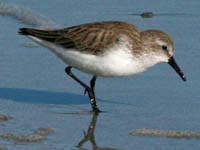
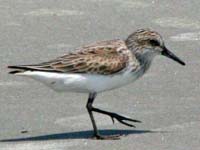
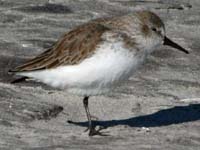
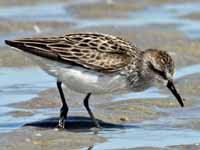
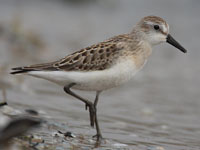
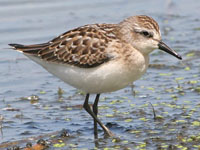
Sandpiper,_Sharp-tailed Calidris acuminata Found: North America (rare), Asia, Australia, Europe, New Zealand, Madagascar (rare)
The breeding Sharp-tailed Sandpiper has rich brown upperparts and breast; white belly; white eye-ring; chestnut crown; light supercilium. The nonbreeding adult has gray upperparts.
Similar to: Pectoral Sandpiper. The Sharp-tailed Sandpiper has a strong eye-ring conpared to the Pectoral Sandpiper.
Image by: 1) Len Blumin - California 2) JJ_Harrison - Australia 3) Alpsdake - Japan 4) Alnus - Taiwan 5) birdsaspoetry Similar to: Pectoral Sandpiper. The Sharp-tailed Sandpiper has a strong eye-ring conpared to the Pectoral Sandpiper.
1) Juvenile 3, 4) Breeding
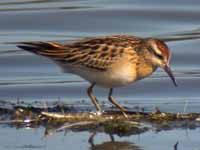
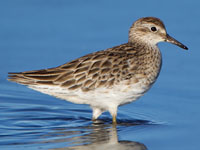
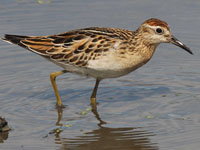

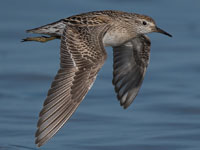
Sandpiper,_Spoon-billed Calidris pygmaea Found: Asia
The breeding Spoon-billed Sandpiper has a spoon-like bill, Breedinghas red-brown head, neck, and breast with dark brown streaks; blackish underparts. Nonbreeding has brownish-gray upperparts; white underparts.
Image by: 1) JJ Harrison - Thailand 2) Gin_Tonic 3) LonelyShrimp 4) Grid_Arendal1, 2, 3) Non breeding 4) Breeding

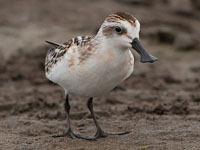
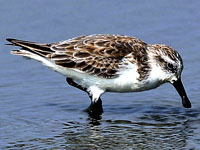

Sandpiper,_Stilt Calidris himantopus Found: The Americas
The breeding Stilt Sandpiper has gray-brown upperparts; heavily barred black and white upperparts; long slightly downturned black bill; white supercilium; long gray-green legs. Nonbreeding adult has gray upperparts; yellow-green legs.
Similar to: Wilson's Phalarope. Nonbreeding Stilt Sandpipers and nonbreeding Wilson's Phalarope are similar. Wilson's Phalarope has white underparts; Stilt Sandpiper has gray breast.
Image by: 1) Len Blumin - Indian Point Park, Texas 2) Dan Pancamo 3) Dominic
Sherony 4) Kevin Pietrzak 5) Francesco VeronesiSimilar to: Wilson's Phalarope. Nonbreeding Stilt Sandpipers and nonbreeding Wilson's Phalarope are similar. Wilson's Phalarope has white underparts; Stilt Sandpiper has gray breast.
3, 4, 5) Breeding adults

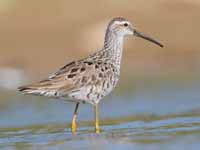
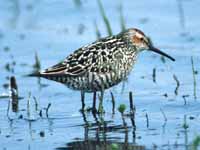
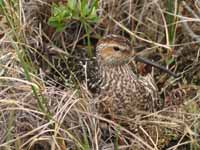
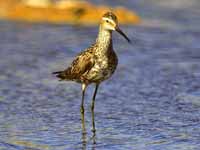
Sandpiper,_Western Calidris mauri Found: The Americas
The breeding Western Sandpiper has rufous upperparts; white underparts; spotted breast; white supercilium; medium length bill with slight droop; black legs. The nonbreeding adult has gray upperparts; nonspotted underparts.
Similar to: Baird's Sandpiper, White-rumped Sandpiper, Baird's / White-rumped Sandpiper considerably larger than Western Sandpiper. Wings of standing Baird's / White-rumped extend beyond tail, but not Western Sandpiper.
Simlar to: Sanderling. Nonbreeding Sanderling upperparts are gray; breeding Sanderling upperparts are rufous. Western Sandpiper is brown.
Similar to: Semipalmated Sandpiper. Western Sandpipter tends to have a longer and more slender bill than the Semipalmated Sandpiper. Western Sandpiper acquires winter plumage much earlier in the autumn than Semipalmated.
Image by: 1) Len Blumin - California 2) Pat and Keith Taylor 3) Alan D. Wilson - British Columbia 6) Jerry Oldenettel - New Mexico 4, 5) Dick Daniels - North Carolina Similar to: Baird's Sandpiper, White-rumped Sandpiper, Baird's / White-rumped Sandpiper considerably larger than Western Sandpiper. Wings of standing Baird's / White-rumped extend beyond tail, but not Western Sandpiper.
Simlar to: Sanderling. Nonbreeding Sanderling upperparts are gray; breeding Sanderling upperparts are rufous. Western Sandpiper is brown.
Similar to: Semipalmated Sandpiper. Western Sandpipter tends to have a longer and more slender bill than the Semipalmated Sandpiper. Western Sandpiper acquires winter plumage much earlier in the autumn than Semipalmated.
1, 2) Juvenile 6) Breeding
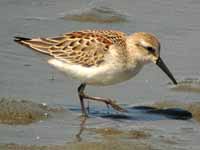
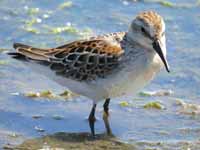
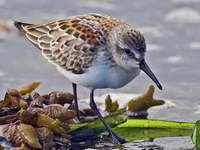
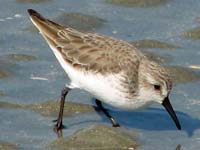
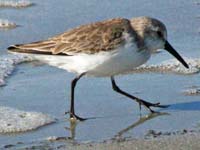
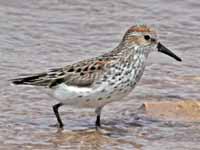
Sandpiper,_White-rumped Calidris fuscicollis Found: The Americas
The breeding White-rumped Sandpiper has graybrown upperparts; mainly white underparts; streaked breast and flanks; white rump; white supercilium; wings extend beyond tail when on the ground. The nonbreeding adult has gray upperparts.
Similar to: Baird's Sandpiper, When flying, the White-rumped Piper has a visible white rump, the Baird's Sandpiper does not.
Similar to: Western Sandpiper, Semipalmated Sandpiper. White-rumped Sandpiper considerably larger than Western and Semipalmated sandpipers. Also, wings of standing Baird's Sandpiper extend beyond tail, but this is not the case for Western and Semipalmated sandpipers.
Image by: 1, 2, 3) Cláudio Timm - Rio Grande do
Sul, Brazil 4) Nick Athanas - ArgentinaSimilar to: Baird's Sandpiper, When flying, the White-rumped Piper has a visible white rump, the Baird's Sandpiper does not.
Similar to: Western Sandpiper, Semipalmated Sandpiper. White-rumped Sandpiper considerably larger than Western and Semipalmated sandpipers. Also, wings of standing Baird's Sandpiper extend beyond tail, but this is not the case for Western and Semipalmated sandpipers.
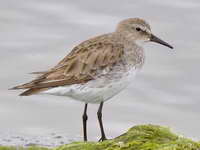

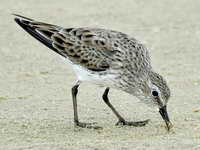
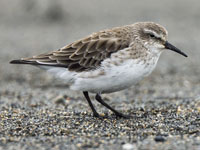
Stint,_Little Calidris minuta Found: North America (rarely) Europe, Asia, Africa, Australa
The breeding Little Stint has orange and rufous upperparts and upper breast; white underparts; short dark bill. The nonbreeding adult has gray upperparts.
Similar to: Red-necked Stint. Difficult to tell apart except at breeding time, then the Red-necked Stint has a red neck and the Little Stint has a white neck.
Image by: 1) Lip Kee Yap 2) Andreas Trepte 3) Ken Billington - Austria 4) Agustin_PovedanoSimilar to: Red-necked Stint. Difficult to tell apart except at breeding time, then the Red-necked Stint has a red neck and the Little Stint has a white neck.
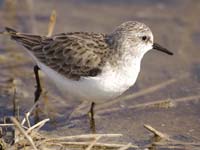
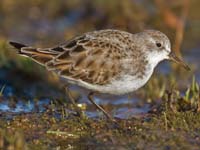
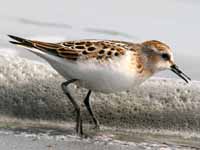

Stint,_Long-toed Calidris subminuta Found: Asia, Australasia
The breeding Long-toed Stint has brown uppeparts and upper-breast; white undeparts; white supercilium; short thin dark bill; greenish-yellow legs with long toes. The nonbreeding adult has gray upperparts.
Similar to: Least Sandpiper. Long-toed Stint has more slender and longer-necked appearance than Least Sandpiper. Ranges do not overlap.
Image by: 1) JJ Harrison - Thailand 2) Alnus - Taoyuan County, Taiwan 3) Alpsdake - JapanSimilar to: Least Sandpiper. Long-toed Stint has more slender and longer-necked appearance than Least Sandpiper. Ranges do not overlap.
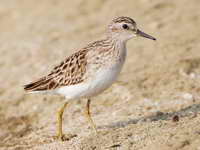
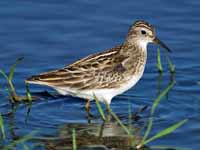

Stint,_Red-necked Calidris ruficollis Found: The Americas (occasional), Europe, Asia, Africa, Australasia
The breeding Red-necked Stint has chestnut back; pinkish chestnut head, neck, breast; black legs. The nonbreeding adult has gray upperparts.
Similar to: Little Stint. Difficult to tell apart except at breeding time, then the Red-necked Stint has a red neck and the Little Stint has a white neck.
Image by: 1) JJ Harrison - Tasmania, Australia 2) Laurie_Boyle 3) Wayne Butterworth 4) David
Cook - Cairns, QLD, Australia 5) Alpsdake - Japan 6) Aaron_Maizlish - CA Similar to: Little Stint. Difficult to tell apart except at breeding time, then the Red-necked Stint has a red neck and the Little Stint has a white neck.
1, 2) Nonbreeding 5, 6) Breeding
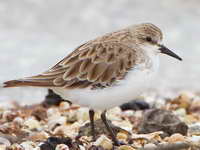
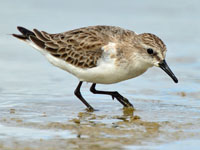
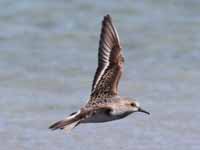
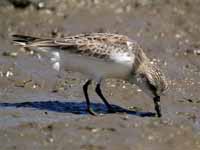
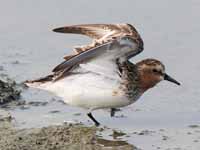
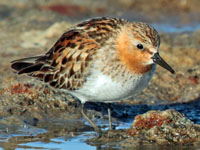
Stint,_Temminck's Calidris temminckii Found: Europe, Asia, Africa
The breeding Temminck's Sandpiper has rufous upperparts, head, upper-breast; white lower-breast, belly. Nonbreeding the rufous changes to brown.
Similar to: Common Sandpiper. Nonbreeding plumage of Common Sandpiper and Temminck's Stint are similar. Temminck's Stint is smaller.
Image by: 1) JM Garg - India 2) Alpsdake - Japan 3) Ron_Knight 4) Andreas Trepte Similar to: Common Sandpiper. Nonbreeding plumage of Common Sandpiper and Temminck's Stint are similar. Temminck's Stint is smaller.
1, 2) Non breeding 3, 4) Breeding

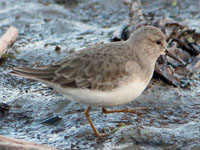
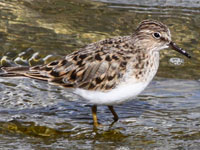
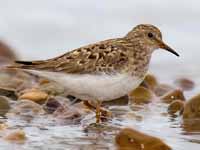
Genus Philomachus - 1 species
Ruff Philomachus pugnax Found: North America (rare), Europe, Africa
The Ruff has a distinctive gravy boat appearance, with a small head, medium-length bill, longish neck and pot-bellied body. It has long legs that are variable in colour but usually yellow or orange.
Image by: 1, 5, 6, 8) Dick Daniels - Sylvan Heights 2) Marek Szczepanek 3) Len Blumin - California 4) Nik_Borrow - England 7, 9) Sandy Cole - Sylvan Heights 10) Cristiano Crolle - near Novara, Italy 11) Frans Vandewalle1) Juvenile 2) Nonbreeding female 3, 4) Breeding female 5 - 10) Males in breeding season
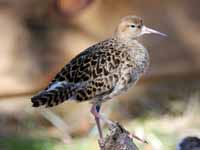
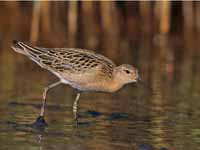

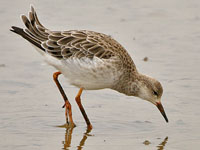
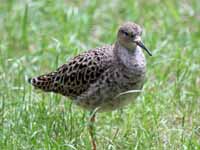

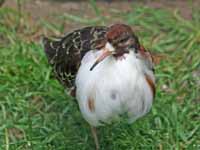
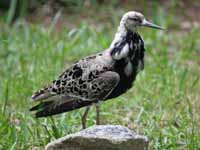
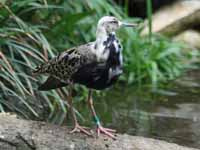
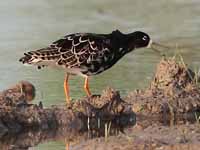
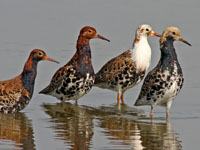
Genus Prosobonia
Sandpiper,_Tuamotu Prosobonia cancellata Found: French Polynesia
The Tuamotu Sandpiper has mottled brown upperparts, flanks; less barred underparts; whitish supercilium.
Image by: 1, 2) Geoff Jones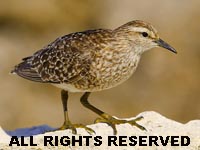
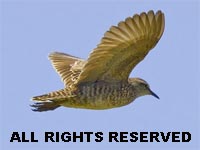
Genus Renaria
Turnstone, Black Renaria melanocephala Found: west coast of North America
The breeding Black Turnstone has plump appearance; black upperparts and breast; white belly; short dark bill; dull reddish-brown legs. The head has white spots, especially on the forehead and above base of bill. The nonbreeding adult has dark brown upperparts and breast; brown head with faint supercilium.
Similar to: Great Knot. Great Knot is larger than Black Turnstone and its bill is proportionally longer.
Similar to: Ruddy Turnstone. Black Turnstone is darker than Ruddy Turnstone. Black Turnstone has solid colored breast; Ruddy Turnstone has dark necklace over a white breast.
Similar to: Surfbird. Black Turnstone is darker than Surfbird. Black Turnstone has upturned bill; Surfbird has straight bill.
Image by: 1) Elaine R. Wilson - California 2) Alan D. Wilson -, La Jolla, California 3, 4 5, 7, 8) Dick - Half Moon Bay, California 6) Len Blumin - Costa Rica Similar to: Great Knot. Great Knot is larger than Black Turnstone and its bill is proportionally longer.
Similar to: Ruddy Turnstone. Black Turnstone is darker than Ruddy Turnstone. Black Turnstone has solid colored breast; Ruddy Turnstone has dark necklace over a white breast.
Similar to: Surfbird. Black Turnstone is darker than Surfbird. Black Turnstone has upturned bill; Surfbird has straight bill.
1 - 5) Nonbreeding 6) Breeding 7, 8 ) Surfbird and Black Turnstone.
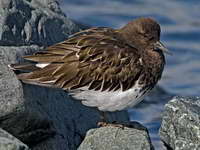
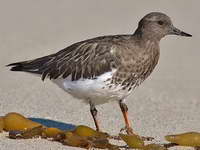
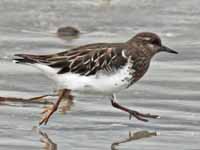

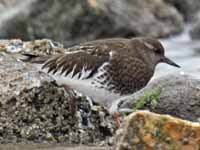
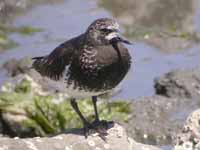
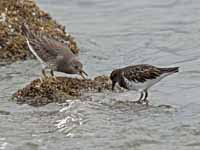
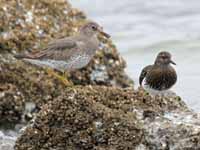
Turnstone, Ruddy Arenaria interpres North America, Europe, Asia, and visits many other coastlines
The breeding Ruddy Turnstone has plump appearance; reddish-brown upperparts with black markings; mostly white head with black pattern around eyes; white underparts with black wide necklace; reddish-orange legs. Nonbreeding adult has grayish-brown upperparts and head; lighter necklace.
Similar to: Black Turnstone. Black Turnstone is darker than Ruddy Turnstone. Black Turnstone has solid colored breast; Ruddy Turnstone has dark necklace over a white breast.
Image by: 1, 2, 7, 8, 10) Dick Daniels - North Carolina 3) Dick - Sanibel Island, Florida 4) Dick - North Carolina 5) Dick - Negril, Jamaica 6) Chesapeak Bay Bridge, Maryland 9) Cristiano Crolle - Texel, Holland Similar to: Black Turnstone. Black Turnstone is darker than Ruddy Turnstone. Black Turnstone has solid colored breast; Ruddy Turnstone has dark necklace over a white breast.
1 - 7) Nonbreeding 8, 9) Breeding
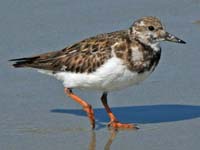
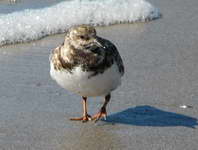
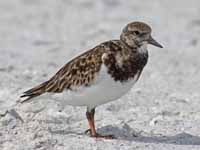
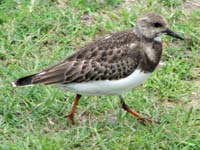
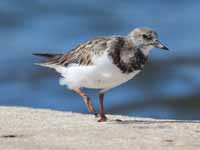
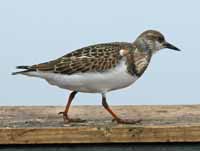
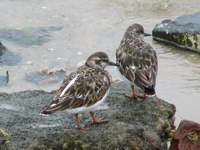
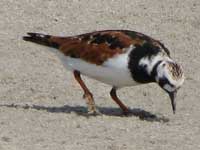
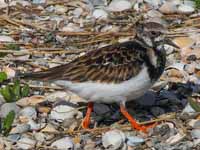
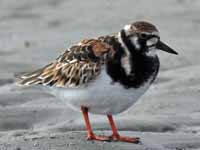
Genus Tryngites - 1 species
Sandpiper,_Buff-breasted Tryngites subruficollis Found: The Americas, Africa
The Buff-breasted Sandpiper has brown upperparts; buff face and underparts; short dark bill; yelllow legs.
Image by: 1) Aaron_Maizlish - CA 2, 3)
Tim Lenz 4) Cláudio
Timm - Rio Grande do Sul, Brazil